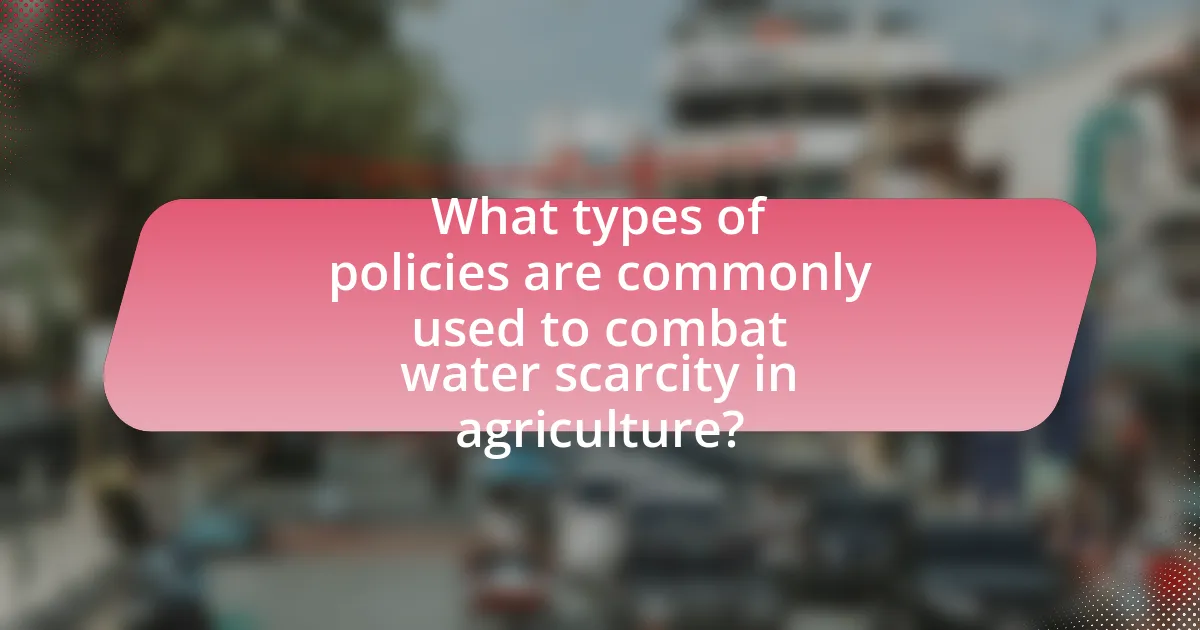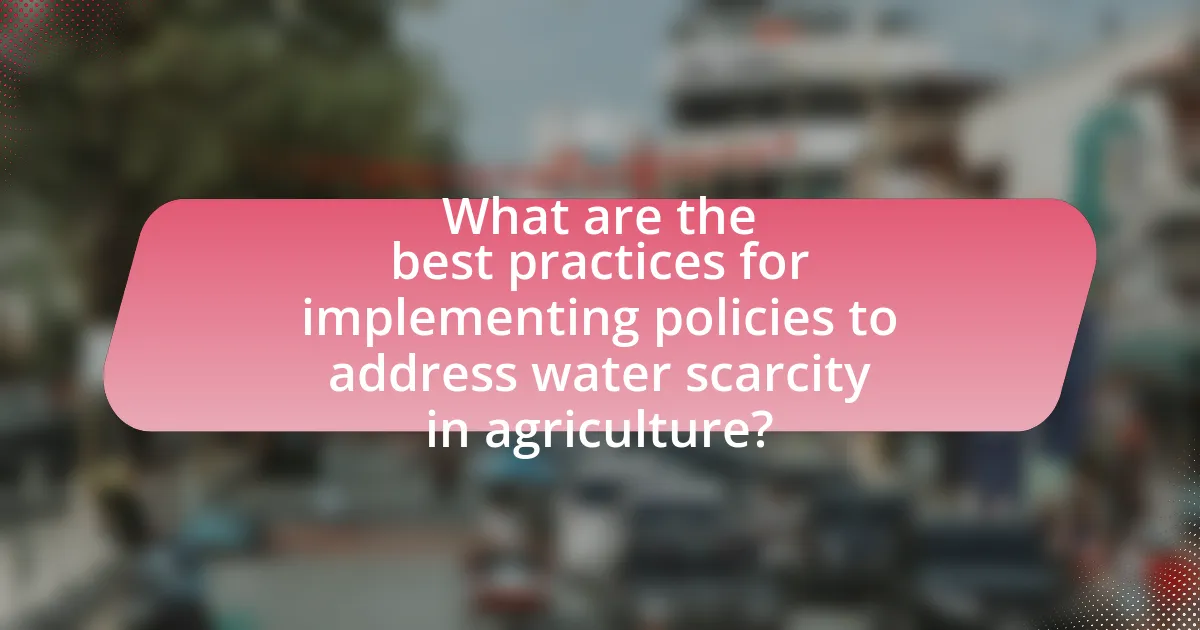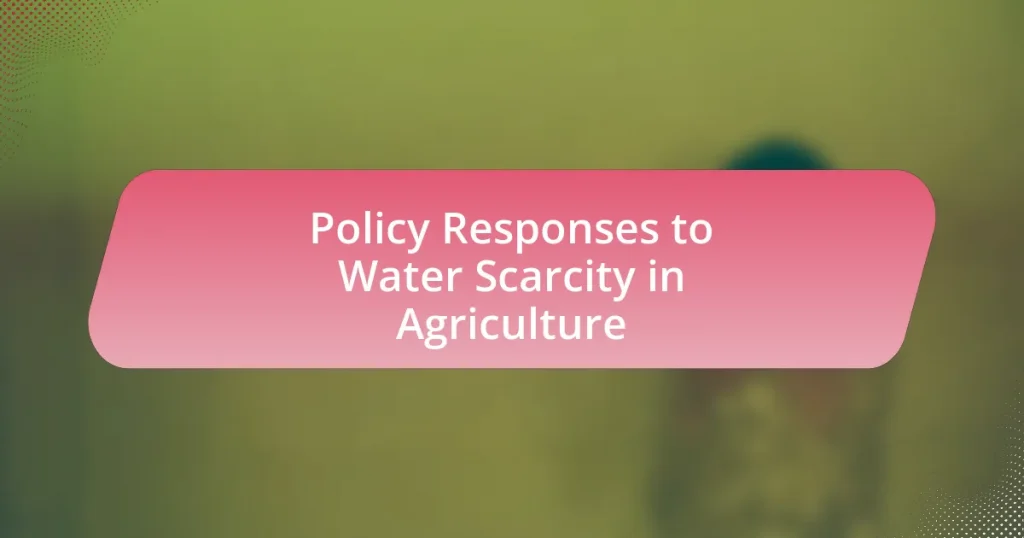The article focuses on policy responses to water scarcity in agriculture, highlighting key strategies such as water pricing mechanisms, investment in irrigation efficiency technologies, and the promotion of sustainable agricultural practices. It discusses how these policies address challenges related to water scarcity by enhancing water management and promoting efficient irrigation techniques. The article also examines regional variations in policy implementation, the importance of regulatory measures, and the role of financial incentives in encouraging water conservation. Additionally, it emphasizes the significance of stakeholder engagement and collaboration between government and agricultural sectors in developing effective policies to ensure sustainable food production and resource management.

What are the key policy responses to water scarcity in agriculture?
Key policy responses to water scarcity in agriculture include the implementation of water pricing mechanisms, investment in irrigation efficiency technologies, and the promotion of sustainable agricultural practices. Water pricing mechanisms encourage conservation by reflecting the true cost of water, which can lead to reduced consumption and more efficient use. Investment in irrigation efficiency technologies, such as drip irrigation and rainwater harvesting, enhances water use efficiency, allowing farmers to maximize crop yields with less water. Additionally, promoting sustainable agricultural practices, such as crop rotation and soil conservation, helps maintain soil health and reduces water demand. These strategies are supported by various studies, including the Food and Agriculture Organization’s reports, which highlight the effectiveness of these policies in improving water management in agriculture.
How do these policies address the challenges of water scarcity?
These policies address the challenges of water scarcity by implementing efficient water management practices and promoting sustainable agricultural techniques. For instance, policies may encourage the adoption of drip irrigation systems, which can reduce water usage by up to 60% compared to traditional methods. Additionally, regulations may support the use of drought-resistant crop varieties, which can thrive with less water, thereby enhancing agricultural resilience. Evidence from various agricultural studies indicates that these approaches not only conserve water but also improve crop yields, demonstrating their effectiveness in mitigating water scarcity challenges.
What specific strategies are implemented in these policies?
Specific strategies implemented in policies addressing water scarcity in agriculture include the promotion of efficient irrigation techniques, the adoption of drought-resistant crop varieties, and the implementation of water conservation practices. Efficient irrigation techniques, such as drip and sprinkler systems, reduce water waste and enhance crop yield. The adoption of drought-resistant crop varieties allows farmers to maintain productivity under limited water availability. Water conservation practices, including rainwater harvesting and soil moisture management, further support sustainable water use in agricultural systems. These strategies collectively aim to optimize water resources and ensure agricultural resilience in the face of water scarcity.
How do these strategies vary by region or country?
Strategies for addressing water scarcity in agriculture vary significantly by region and country due to differences in climate, economic conditions, and agricultural practices. For instance, in arid regions like the Middle East, countries such as Israel implement advanced irrigation technologies and water recycling methods to maximize water efficiency. In contrast, countries in sub-Saharan Africa may focus on rainwater harvesting and community-based management approaches due to limited infrastructure and resources. Additionally, European nations often emphasize regulatory frameworks and subsidies to promote sustainable water use in agriculture, reflecting their economic capacity and environmental policies. These variations highlight the need for tailored approaches that consider local conditions and challenges in managing water resources effectively.
Why is it important to develop policies for water scarcity in agriculture?
Developing policies for water scarcity in agriculture is crucial to ensure sustainable food production and resource management. Effective policies can help allocate limited water resources efficiently, promote conservation practices, and support farmers in adapting to changing climatic conditions. For instance, the Food and Agriculture Organization (FAO) reports that agriculture accounts for approximately 70% of global freshwater use, highlighting the need for strategic management to prevent over-extraction and degradation of water sources. By implementing policies that encourage efficient irrigation techniques and crop selection based on water availability, agricultural productivity can be maintained while safeguarding water resources for future generations.
What are the potential impacts of water scarcity on agricultural productivity?
Water scarcity significantly reduces agricultural productivity by limiting the availability of water necessary for crop growth and livestock maintenance. When water resources are insufficient, crop yields decline, leading to lower food production and increased prices. For instance, the Food and Agriculture Organization (FAO) reports that water scarcity can reduce crop yields by up to 50% in some regions, directly impacting food security. Additionally, prolonged water shortages can lead to soil degradation and reduced soil fertility, further exacerbating the decline in agricultural output. This situation creates a cycle of reduced productivity and increased vulnerability for farmers, particularly in arid and semi-arid regions where agriculture heavily relies on irrigation.
How does water scarcity affect food security and rural livelihoods?
Water scarcity significantly undermines food security and rural livelihoods by limiting agricultural production and increasing food prices. When water resources are insufficient, crop yields decline, leading to reduced food availability. For instance, the Food and Agriculture Organization (FAO) reports that water scarcity affects over 1.2 billion people globally, directly impacting their ability to produce food. Additionally, rural communities that rely on agriculture for their income face economic instability as water shortages lead to lower harvests and increased competition for limited resources. This situation exacerbates poverty and food insecurity, as families struggle to afford basic necessities.

What types of policies are commonly used to combat water scarcity in agriculture?
Commonly used policies to combat water scarcity in agriculture include water pricing, irrigation efficiency programs, and regulatory measures. Water pricing incentivizes farmers to use water more efficiently by reflecting the true cost of water supply, which can lead to reduced consumption. Irrigation efficiency programs promote the adoption of advanced technologies, such as drip irrigation, which can significantly decrease water usage while maintaining crop yields. Regulatory measures, such as water allocation rights and restrictions on water use during drought periods, help manage and distribute water resources more equitably among agricultural users. These policies are supported by various studies indicating their effectiveness in reducing water consumption and enhancing sustainability in agricultural practices.
What role do regulatory policies play in managing water resources?
Regulatory policies play a crucial role in managing water resources by establishing frameworks that govern water allocation, usage, and conservation. These policies ensure sustainable water management practices, protect water quality, and promote equitable access among users. For instance, regulations may limit water extraction rates to prevent overuse, as seen in California’s Sustainable Groundwater Management Act, which mandates local agencies to develop plans for sustainable groundwater management. Such policies are essential for addressing challenges like water scarcity, particularly in agriculture, where efficient water use is vital for food production and environmental sustainability.
How do regulations influence water usage in agricultural practices?
Regulations significantly influence water usage in agricultural practices by establishing limits on water extraction, promoting efficient irrigation techniques, and incentivizing sustainable water management. For instance, laws such as the Clean Water Act in the United States impose restrictions on water pollution, which indirectly affects water availability for agriculture by ensuring that water sources remain clean and usable. Additionally, regulations may require farmers to adopt technologies like drip irrigation, which can reduce water consumption by up to 50% compared to traditional methods. Studies have shown that regions with stringent water management policies experience more sustainable agricultural practices, leading to improved water conservation and reduced competition for water resources.
What are the challenges of enforcing these regulations?
The challenges of enforcing regulations related to water scarcity in agriculture include lack of compliance, insufficient monitoring, and limited resources for enforcement. Farmers may resist regulations due to economic pressures or lack of understanding, leading to non-compliance. Additionally, monitoring water usage effectively requires significant investment in technology and personnel, which many regulatory bodies may lack. For instance, a study by the Food and Agriculture Organization highlights that only 30% of countries have adequate monitoring systems in place to enforce water regulations effectively. Furthermore, limited financial and human resources hinder the ability of authorities to implement and enforce these regulations consistently.
How do financial incentives support water conservation in agriculture?
Financial incentives support water conservation in agriculture by encouraging farmers to adopt efficient water management practices. These incentives, such as subsidies for irrigation technology or tax breaks for water-saving measures, reduce the financial burden on farmers, making it economically viable to implement conservation strategies. For instance, a study by the World Bank found that countries offering financial incentives saw a 20% increase in the adoption of water-efficient irrigation systems, leading to significant reductions in water usage. This demonstrates that financial incentives effectively motivate agricultural stakeholders to prioritize water conservation, thereby addressing water scarcity challenges.
What types of financial incentives are most effective?
The most effective types of financial incentives for addressing water scarcity in agriculture include direct subsidies, tax credits, and performance-based payments. Direct subsidies provide farmers with immediate financial support to adopt water-saving technologies, which has been shown to increase adoption rates significantly. For instance, a study by the World Bank indicated that farmers receiving subsidies for drip irrigation systems increased their water efficiency by up to 30%. Tax credits incentivize investments in sustainable practices, encouraging long-term changes in water management. Performance-based payments reward farmers for measurable improvements in water conservation, aligning financial benefits with environmental outcomes. Research from the Food and Agriculture Organization highlights that such incentives can lead to a 20% reduction in water usage among participating farmers.
How do subsidies impact farmers’ water usage behaviors?
Subsidies significantly influence farmers’ water usage behaviors by incentivizing increased water consumption and altering irrigation practices. When financial support is provided for water-intensive crops or irrigation systems, farmers are more likely to utilize greater amounts of water, often leading to inefficient usage. For instance, a study by the World Bank found that in regions where subsidies were prevalent, water usage increased by up to 30% for certain crops, as farmers prioritized short-term gains over sustainable practices. This behavior can exacerbate water scarcity issues, particularly in arid regions, as the reliance on subsidies can create a cycle of dependency that discourages the adoption of water-saving technologies.

What are the best practices for implementing policies to address water scarcity in agriculture?
The best practices for implementing policies to address water scarcity in agriculture include promoting efficient irrigation techniques, enforcing water use regulations, and incentivizing sustainable farming practices. Efficient irrigation techniques, such as drip irrigation, can reduce water usage by up to 60% compared to traditional methods, thereby conserving water resources. Enforcing regulations on water usage ensures that agricultural practices do not exceed sustainable limits, which is crucial in regions facing severe water shortages. Additionally, providing incentives for sustainable farming practices, such as crop rotation and drought-resistant crops, encourages farmers to adopt methods that enhance water conservation. These practices collectively contribute to a more sustainable agricultural sector in the face of increasing water scarcity.
How can stakeholder engagement improve policy effectiveness?
Stakeholder engagement can improve policy effectiveness by ensuring that diverse perspectives and expertise are incorporated into the decision-making process. This inclusion leads to more informed policies that address the specific needs and challenges faced by various groups, such as farmers, water managers, and local communities. For instance, research conducted by the Food and Agriculture Organization highlights that policies developed with stakeholder input are more likely to gain public support and compliance, resulting in better implementation outcomes. Engaging stakeholders also fosters collaboration, which can lead to innovative solutions and resource-sharing that enhance the overall effectiveness of water management policies in agriculture.
What methods can be used to involve farmers in policy development?
Farmers can be involved in policy development through participatory approaches, such as stakeholder consultations, focus groups, and collaborative workshops. These methods facilitate direct engagement, allowing farmers to voice their concerns and contribute their knowledge, which is essential for creating effective policies. Evidence from the Food and Agriculture Organization indicates that involving farmers in policy discussions leads to more relevant and sustainable agricultural practices, as policies are better aligned with the realities faced by farmers.
How does collaboration between government and agricultural sectors enhance outcomes?
Collaboration between government and agricultural sectors enhances outcomes by facilitating resource allocation, policy implementation, and innovation in water management practices. This partnership allows for the development of targeted policies that address specific challenges, such as water scarcity, by leveraging government resources and agricultural expertise. For instance, the implementation of the Agricultural Water Management Program in California, which involved collaboration between state agencies and farmers, resulted in a 20% increase in water use efficiency among participating farms. Such collaborative efforts lead to improved sustainability, increased crop yields, and better economic viability for farmers, ultimately contributing to food security and environmental conservation.
What lessons can be learned from successful policy implementations?
Successful policy implementations in addressing water scarcity in agriculture demonstrate the importance of stakeholder engagement, evidence-based decision-making, and adaptive management. Stakeholder engagement ensures that the needs and perspectives of farmers, local communities, and water management authorities are considered, leading to more effective and accepted policies. Evidence-based decision-making, supported by data and research, allows policymakers to design interventions that are tailored to specific regional challenges, as seen in the implementation of water-saving technologies in Israel, which increased agricultural productivity while reducing water use. Adaptive management, which involves continuous monitoring and adjustment of policies based on outcomes, has proven effective in regions like California, where water management strategies are modified in response to changing climatic conditions and water availability. These lessons highlight the necessity of collaboration, data utilization, and flexibility in crafting successful policies for water scarcity in agriculture.
Which countries have effectively managed water scarcity in agriculture?
Israel has effectively managed water scarcity in agriculture through advanced irrigation techniques and water recycling. The country utilizes drip irrigation systems that minimize water waste and maximize crop yield, achieving over 90% efficiency in water use. Additionally, Israel recycles approximately 90% of its wastewater for agricultural purposes, making it a global leader in sustainable water management practices. Other countries, such as Spain and Australia, have also implemented successful policies and technologies to address water scarcity in agriculture, focusing on efficient irrigation methods and water conservation strategies.
What key factors contributed to their success?
The key factors that contributed to the success of policy responses to water scarcity in agriculture include effective water management practices, technological innovation, and stakeholder engagement. Effective water management practices, such as the implementation of irrigation efficiency measures, have been shown to significantly reduce water usage while maintaining crop yields. Technological innovations, including the development of drought-resistant crop varieties and advanced irrigation systems, have enhanced agricultural resilience to water scarcity. Additionally, stakeholder engagement, involving farmers, policymakers, and community organizations, has facilitated the adoption of sustainable practices and ensured that policies are tailored to local needs, leading to more successful outcomes in addressing water scarcity challenges.
What practical steps can farmers take to adapt to water scarcity policies?
Farmers can adapt to water scarcity policies by implementing efficient irrigation techniques, such as drip irrigation and rainwater harvesting. These methods significantly reduce water usage compared to traditional irrigation systems, with drip irrigation using up to 60% less water while delivering it directly to the plant roots. Additionally, farmers can adopt drought-resistant crop varieties, which are specifically bred to thrive in low-water conditions, thereby ensuring yield stability despite reduced water availability. Implementing soil moisture monitoring technologies allows farmers to optimize irrigation schedules based on actual soil needs, further conserving water. According to the Food and Agriculture Organization, these practices can lead to a 30-50% reduction in water consumption in agriculture, demonstrating their effectiveness in adapting to water scarcity policies.















